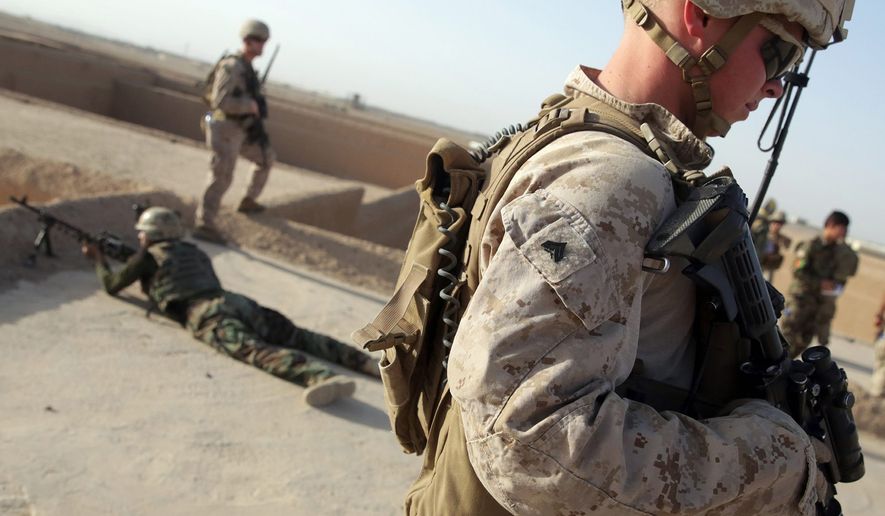A week after President Trump outlined his new plan for the war in Afghan, the Defense Department has begun drafting the battle plan to make his vision a reality in the troubled 16-year-old war. But the early drafts, being overseen by Chairman of the Joint Chiefs of Staff Gen. Joseph Dunford, appear at odds with actions already undertaken by U.S. wartime commanders.
Gen. Dunford and Defense Secretary James Mattis are still in the early stages of implementing the White House’s new strategy. Mr. Trump’s plan, unveiled in a prime time address earlier this month, was heavy on rhetoric but light on critical details — including how many more U.S. troops would be heading to Afghanistan to battle the Taliban and a growing Islamic State presence.
Mr. Trump insisted the U.S. will be abandoning the timeline-based approach to the Afghanistan mission in favor of a “conditions-based” strategy. Administration critics claim the decision will effectively restart U.S.-led combat operations in Afghanistan, which President Obama officially ended in late 2014, forcing the U.S. into a conflict with no end in sight.
American military officials insist the details of the White House’s Afghan strategy are still being worked out, despite Mr. Trump’s highly touted speech.
“We are just not there yet. There is work to be done here in the department, and answers that have to be provided to Secretary Mattis,” said Pentagon spokesman Col. Robert Manning.
Mr. Mattis will determine troop numbers and other elements required to execute the new Afghan war plan. The White House earlier this year announced that setting troop levels for Afghanistan, as well as in the fight against the Islamic State in Iraq and Syria, would fall to the Pentagon chief. Mr. Mattis, along with National Security Adviser H.R. McMaster are looking to add an additional 3,900 American troops into Afghanistan.
Currently there are 8,400 troops stationed in Afghanistan, with a majority of those forces supporting the NATO-led military adviser mission dubbed Operation Resolute Support. Other American troops, mostly special operations units, are conducting missions against the Taliban and Islamic State under Operation Freedom’s Sentinel.
Col. Manning declined to comment on whether Mr. Trump’s new strategy puts Washington on the path back to full combat operations in Afghanistan, or whether the current missions in which U.S. forces are engaged will be shut down in favor of a more aggressive combat role.
“We are approaching this very deliberately, but we are not there yet,” Col. Manning told reporters at the Pentagon on Monday. But the vagueness of the strategy has left many questions yet to be answered.
Prior to Mr. Trump’s speech, Mr. Mattis told reporters the Pentagon would lay out a series of specific options to the president for the way ahead in Afghanistan.
“Now just make the decision. There’s the options,” he said last week. As a result, U.S. Central Command Chief Gen. Joseph Votel would begin “pretty quickly” sending in the first tranche of new American troops into the country, based on the President’s decision.
But Gen. Dunford’s review is casting doubt on what exactly the president agreed to, and how much of that was now subject to change. Mr. Trump is widely reported to be unhappy with the options he was given in what is now the longest war in U.S. history, in which the Taliban and other groups appear to have the initiative against the struggling government of Afghan President Ashraf Ghani.
Underscoring the challenges ahead for the U.S. and Afghanistan, The Associated Press reported that a suicide bombing in a busy commercial area in Kabul near a string of banks and not far from the U.S. Embassy killed at least five people on Tuesday. The Taliban claimed responsibility for the attack.
Elsewhere, at least 13 civilians were killed in an overnight airstrike by the Afghan air force that targeted the Taliban in western Herat province.
In the Kabul attack, the explosion likely targeted a branch of the privately owned Kabul Bank, according to Basir Mujahid, spokesman for the Kabul police chief. The U.S. Embassy compound is located about 500 yards down the road from the bank.
Mr. Trump in his address said American troops would “fight to win” by attacking enemies, “crushing” al Qaeda, preventing terrorist attacks against Americans and “obliterating” the Islamic State group, whose affiliate has gained a foothold in Afghanistan as the U.S. squeezes the extremists in Syria and Iraq. He also criticized Pakistan for continuing to harbor Islamist terror groups that were fighting the government in Kabul.
• This article was based in part on wire service reports.
• Carlo Muñoz can be reached at cmunoz@washingtontimes.com.




Please read our comment policy before commenting.